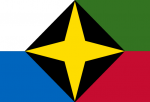Kúúlist symbolism
| Part of a series on the |
| Helsonian Union |
|---|
 |
| Part of a series on |
| Balko-Kúúlism |
|---|
 |
| V•T•E |
Kúúlist symbolism represents a variety of themes, including revolution, the proletariat, justice, and comradery. Kúúlist states, parties and movements use these symbols to advance and create solidarity within their cause.
In Cerman (possibly others), the displaying of Kúúlist imagery outside of an educational or historical context is illegal.
Four-pointed star
Originally a purely Helsonian symbol, the four-pointed star represented the four Supreme Helsonias: north (Amerhan), east (Terminia), south (Utol) and west (Terminia Minor). The symbol arose under the Statist movement in 1942, who also claimed it was the net of a pyramid, representing the top-down power structure advocated by the movement.
The four-pointed star has, since the Great Ekuosian War, become widely associated with Kúúlism, appearing in the emblems and flags of several international Kúúlist movements, including the emblem of Qonklaks.
Other uses

The four-pointed star has other uses in a variety of cultural contexts. A golden four-pointed star appears for example on the national flag of Tabiqa, however there it is tied to symbolism of the Quurožarq, representing the compass rose, the Four Great Gods and Quuros. Ironically, Tabiqa is a right-wing authoritarian capitalist state.
Circle and dot
The "circle and dot" is today most often used by Orthodox Kúúlists, in order to distance themselves from the legacy of the Helsonian Union. Originally designed by name Kúúl and featured in the first Kúúl Thesis in 1878, it is meant to represent the divided class system of capitalism - the dot being the ruling bourgeoisie and a circle with a hole in the centre the majority proletariat. Thus, a complete circle represents an ideal classless society.
The emblem of the Adhelsonian Provisional State (pictured here) is a variation of the circle and dot.
Amber flag

The amber flag is most often seen in combination with other Kúúlist symbols, and is used at various Kúúlist rallies and protests. Being a symbol of revolution in general, it is sometimes used outside of a Kúúlist context.
The flag, at its earliest, originated as a rallying icon for republicans in 1700s Terminia, who sought to overthrow the monarchy and establish a democratic system modelled on Rosland and Shohuan. Amber was chosen to represent a "new dawn" for human civilisation. The flag was heavily used during the Terminian Revolution, and remained the flag of post-revolution Helsonia for 17 years.
Scales
Equality of all people, one of the most important aspects of Kúúlism, is represented by a pair of scales.
Later, Statist movements also used scales to represent the justice and benevolence of the state, and thus scales could be found on the emblems of most Helsonian government ministries, as well as the State Emblem itself.
Gears
Gears began to be associated with Kúúlism after the industrialisation of the Helsonian Union, when the majority of the working population switched from agriculture and farming to urbanised, factory-based jobs. The gear is therefore regarded as a more modern representation of the proletariat.
In Utol, which has remained largely rural throughout its history, various other symbols were used instead of a gear, for example in the emblem of the Utollian SHR.
Other symbols
Several other symbols may also be associated with Kúúlism or similar movements:
- Head of wheat, exemplified on the Dhweran coat of arms.




